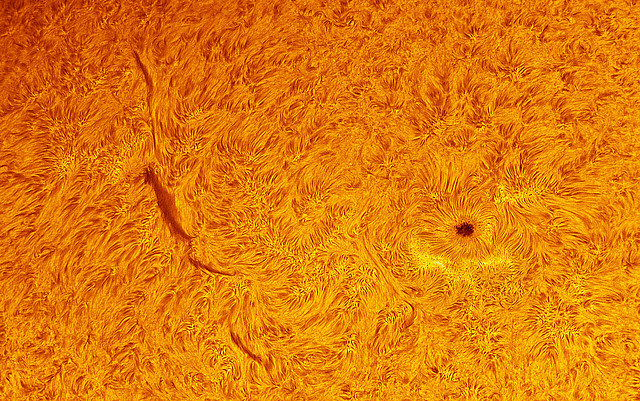Fun with Spectroscopy!
http://www.rolfolsenastrophotography.com
Copyright: Rolf Wahl Olsen
Link to large image: https://www.rolfolsenastrophotography.c ... -Fc3VfvZ/O
This image is a comparison of a range of spectra taken of 31 naked eye stars visible from the Southern hemisphere. Spectra were taken with a StarAnalyzer diffraction grating mounted in the filter wheel of my CCD camera on a 12.5" Newtonian telescope. Each spectrum was processed using RSpec software and calibrated for instrument response. The resulting spectra show the black body radiation profile of the various stellar types and their typical spectral line features.
The star spectra are ordered according to stellar type, with hot blue stars at the top and cooler red stars towards the bottom. Hot blue stars (O, B, A types) have a light profile heavily skewed towards the left (blue and violet) end of the spectrum given these stars emit the majority of their energy at short wavelengths. They also display the famous Hydrogen Balmer series of absorption lines.
In the centre are the F, G and K type stars with their more even light profiles and numerous but fainter absorption lines.
Towards the bottom are the cooler M type stars with profiles heavily skewed towards the red and infrared end of the spectrum. Then also show many broad absorption lines form Titanium Oxide molecules suspended in their cool atmospheres.
At the very bottom are two examples of Wolf-Rayet stars that have unusual spectra with some prominent emission lines.
Also visible are a couple of absorption lines in the red, which appear in every single spectrum regardless of spectral type. These are caused by terrestrial oxygen in the Earth's atmosphere.
The background image is my deep photo of cometary globules CG 30, CG 31 and CG 38 in Puppis.
Image details:
Date: 29 May, 1 July 2021
Exposure: Luminance 0.03s - 3s @ -25C
Telescope: Homebuilt 12.5" f/4 Serrurier Truss Newtonian
Camera: QSI 683wsg with Lodestar guider
Filters: StarAnalyzer 200 Diffraction Grating
Taken from my observatory in Auckland, New Zealand


 A Summers Night - Fireflies and the Milky Way by HDG Studios, on Flickr
A Summers Night - Fireflies and the Milky Way by HDG Studios, on Flickr
 IC 1848 PALETA HUBBLE by ivan izquierdo bernal, en Flickr
IC 1848 PALETA HUBBLE by ivan izquierdo bernal, en Flickr Sun in H-Alpha 17th June 2021 by Alessandro Carrozzi, su Flickr
Sun in H-Alpha 17th June 2021 by Alessandro Carrozzi, su Flickr Sun in H-Alpha 17th June 2021 by Alessandro Carrozzi, su Flickr
Sun in H-Alpha 17th June 2021 by Alessandro Carrozzi, su Flickr Sun in H-Alpha 17th June 2021 by Alessandro Carrozzi, su Flickr
Sun in H-Alpha 17th June 2021 by Alessandro Carrozzi, su Flickr
